Photo
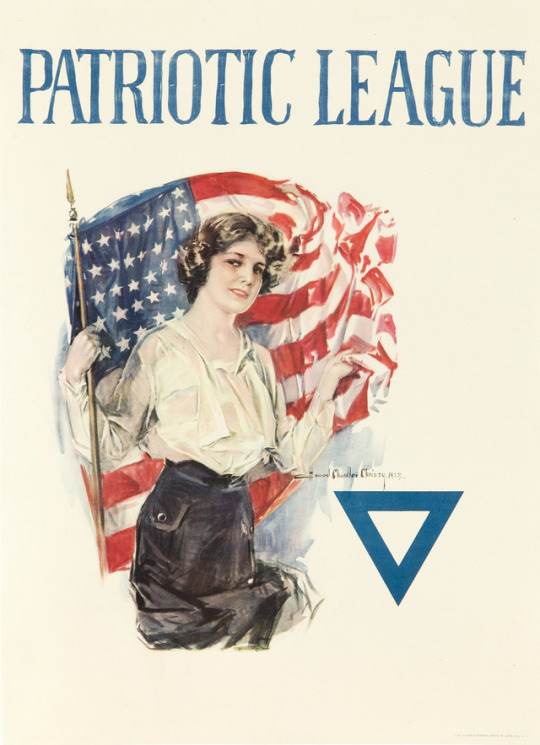
Patriotic League, by Howard Chandler Christy, 1918.
#flg#christy#patriotic#league#patriotism#propaganda#vintage poster#beautiful girl#vintage posters#poster#posters#vintage#affiche#world war 1#world war 2#ww1#ww2#old glory#stars and stripes#stars and bars#triangle#red#white#blue#1910s
65 notes
·
View notes
Photo

Saturday Evening Post cover, by Norman Rockwell, July 1940.
#norman rockwell#rockwell#saturday evening post#americana#vintage posters#illustration#ice cream cone#melting#dripping wet#beach#love#umbrellas#summer#vacation#travel#hot#heat#1940#affiche#plakat
205 notes
·
View notes
Photo
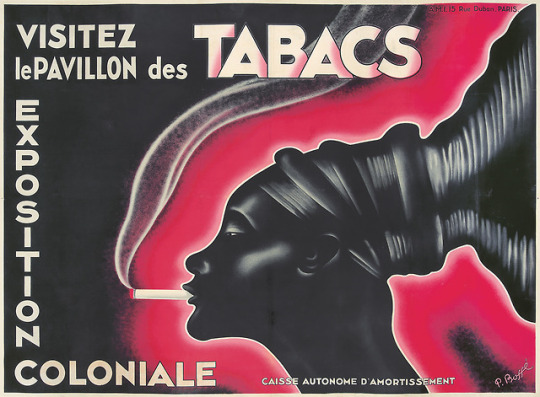
Pavillion des Tabacs. 1931. P. Bosse.
78 3/8 x 57 1/4 in./199 x 145.4 cm
An electric-pink neon glow surrounds a stylized bust of a smoking African woman in a convergence of modern and traditional aesthetics. The Exposition Coloniale of Paris, held in 1931, attempted to paint France's colonial empire in a positive light by demonstrating mutually beneficial cultural exchange. The expo attracted between 7 and 9 million visitors from around the world.
Available at auction June 26. Learn More>>
#smoking girl#african#african woman#coloniale#tabacs#tobacco#cigarettes#colonialism#imperialism#empire#french empire#1930s#jazz age#art deco#pink#hot pink#bosse#vintage posters#posters#type design#typography#font design#font#african hair#hair#drag#inhale#exhale#pull#smoking
102 notes
·
View notes
Photo
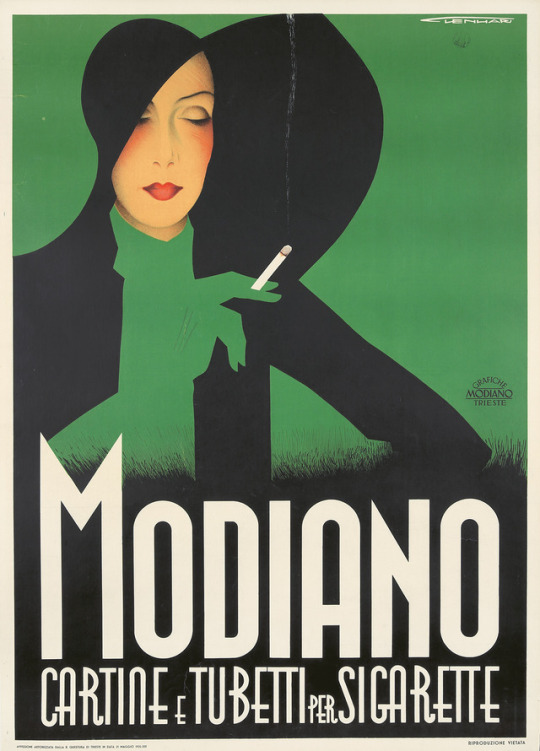
Modiano. 1933. Franz Lenhart.
39 1/8 x 55 in./99.3 x 139.6 cm
For the Modiano brand of prefabricated rolling paper tubes, Lenhart plays us an engaging optical game of silhouettes: the black outfit of the Garbo-like femme fatale like a cutout against the green background, the blouse and the hand cut out in turn from the black; standing out from both, the warmly glowing face and the white cigarette. Most elegant! Born in Bavaria, Lenhart studied in Italy and settled there permanently in 1922 to work and teach.
Available at Auction June 26.
#modiano#franz lenhart#rolling papers#garbo#cigarette#cigarettes#cigarette advertising#smoking#smoke#420#green#black and green#type design#italian#1920s#vintage posters#poster#affiche#lenhart#beautiful woman#eleganza#lipstick#vintage clothes#retro#style#fashion#roaring 20s#jazz age#art deco#graphic design
261 notes
·
View notes
Photo

Philippossian Automobiles. 1920. Charles Loupot.
50 3/4 x 35 3/8 in./128.8 x 90 cm
A flame-haired Femme Fatale, dressed in black, launches this midnight-blue beast of an auto into the foggy night: a masterpiece! Exceptionally rare, this poster finds Loupot at the absolute apex of his transition period between Switzerland and France, between domestic traditionalism and aggressive Modernist experimentation. According to Loupot's son, Jean-Marie, until this point Loupot was hired by printers; this was likely his first direct commission from the advertiser (alongside his wildly successful Philippossian Cigarettes, see PAI-LXX, 443). The typeface, with which he'd been experimenting with since at least the previous year (see "Plantol," PAI-XXI, 270) now achieves a refined state of Deco precision. This poster appears to be the sole remnant of any flirtation the advertiser Charles Philippossian had with the auto industry. However, it's clear that the brilliance of this piece served as Loupot's introduction to an entirely new market, as a creator of the new Art Deco aesthetic. In the following years, he'd create superb work for Swiss Grand Prix autos and motorcycles; Austin Tractors; and Voisin Autos, before defining the industrial Art Deco aesthetic at the 1925 Expo, and with classics such as "Stop-Fire." An important work by this artist. Exceptionally rare.
Available at Auction June 26.
#philippossian#automobiles#charles#loupot#art deco#modernist#type design#font design#vintage cars#open road#roadster#jazz age#ginger#redhead#flaming hair#vintage posters#poster#affiche#plakate#rare posters#art of paris#french#art#vintage#retro style#retro#femme fatale#blue car
99 notes
·
View notes
Photo

Motobécane. ca. 1929. Geo Ham.
46 3/4 x 31 in./118.7 x 78.7 cm
Geo Ham had a need: a need for speed. Known as the "prince of motion," he is famous today as the illustrator of Monaco Grand Prix posters from 1933 to 1936, as well as motorboat competitions, air meets and aerobatic competitions between the wars. He produced exactly two posters for Motobécane: this one, presumably the earlier of the two: despite the lady's scarf waving in the breeze, there isn't quite as much of a kinetic frisson as Ham's more mature works. The other Ham Motobécane is directly adjacent.
Available at auction June 26. Learn more >>
#geo ham#motobécane#1920s#motorcycles#motorbikes#motorbike#art deco#gatsby#jazz age#flapper#vintage sweater#vintage bikes#gearhead#motorhead#open road#scarf#deco fashion#1920s fashion#sunset#vintage psoters#posters#affiches#plakate#prince of motion#pai-lxxv#rare posters#lithography#art on paper#poster love#print
84 notes
·
View notes
Photo
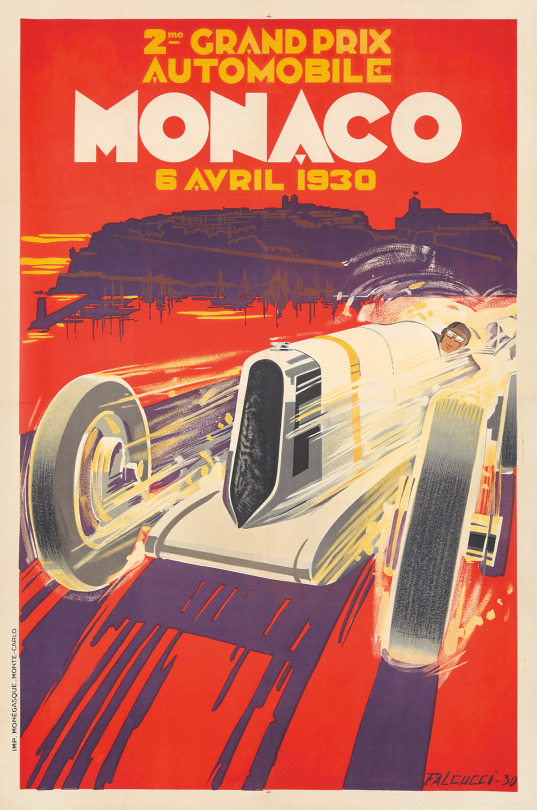
Monaco Grand Prix 1930. Robert Falcucci.
31 1/4 x 47 3/8 in./79.3 x 120.3 cm
It's a red, red, ripping and roaring sunset in this gripping design by Falcucci. Created for the second running of the Monaco Grand Prix, it's arguably one of the best created for the event. (The first Grand Prix was just announced with text; this the first image done for the competition.) We don't know the maker of this blazing white beast of a racecar, but René Dreyfus took the checkered flag that year in his Bugatti T35B.
Available at auction June 26. Learn more >>
#monaco grand prix#monaco#monte carlo#grand prix#1930s#robert falcucci#falcucci#Italian art#italian design#graphic design#illustration#pic of the day#race car#automobile#vintage#vintage poster#red sky#mediterranean#french riviera#art deco#jazz age#roadster#pedal to the metal#motorhead#gearhead#car lover#racecar#racetrack#red#purple mountains
145 notes
·
View notes
Photo
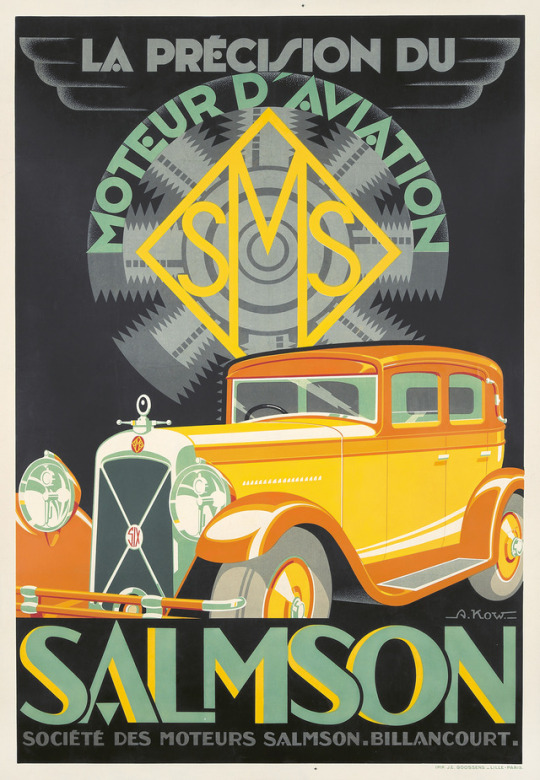
Salmson. ca. 1929. Alexis Kow.
42 3/4 x 62 5/8 in./108.6 x 159 cm
Salmson began as a manufacturer of water-cooled airplane engines. Consequently, the poster boasts that the car has the precision of these airplane motors. Their first automobiles appeared in 1921, and graduated from amusing cyclecars to sports cars, and from there to majestic luxury sedans like this one. In 1925, Salmson won 76 races and set 14 speed records for its class. Russian-born Kow created smart and sleek automobile print advertisements and posters. Here, he makes effective use of strong, flat colors, with the Salmon insignia shining above, as the blurry whir of a plane engine spins in the background.
Available at auction June 26. Learn more >>
#salmson#alexis kow#societe des moteurs salmson#billancourt#logo#icon#logo design#art deco#vintage posters#posters#affiche#plakat#luxury sedan#1920s#gatsby#jazz age#russian art#automobiles#vintage cars#car show#sedan#yellow car#gold#color palette#aviation#motor#insignia#plane engine#engine design#gear head
139 notes
·
View notes
Photo

Ford. 1933. Anonymous.
30 5/8 x 45 3/4 in./77.8 x 116.2 cm
"Ford introduced the V-8 engine in 1932, and this poster for the following year's model showcases its promotional message ("Ford lets fly this arrow to show the road of progress") with a striking Art Deco take on classicism. Ford was the first company to cast a V-8 engine block in one piece. It was many years before the company's competitors learned how to mass-produce a reliable V-8; in the interim, the car and its powerful engine became the preferred choice of performance-minded motorists worldwide" (Crouse/Deco, p. 46).
Available at auction June 26. Learn more >>
#ford motors#ford motor company#vintage engine#v-8#v8#v-8 engine#car engine#art deco#vintage advertising#advertising#engine block#under the hood#motor#bow and arrow#archery#poster auctions#pai-lxxv#rare posters#jazz age#1930s#classism#classic#classic engine#assembly line#henry ford#vintage posters#posters#plakat#affiches#poster
114 notes
·
View notes
Photo

Peugeot. 1900. Rene Vincent.
46 5/8 x 61 1/2 in./118.5 x 156.2 cm
This absolute monster of a chassis, careening out of a Tricoleur sky, bounding along with wheels in the air, is not exactly correct. It appears to be a hybrid of the 1913 and the 1916 Peugeots, which each won the Indianapolis 500: the wishbone front suspension is 1916; the configuration of the chassis, more 1913; but the actual artifacts have a slight upward curve as the hoods reach the steering wheel. Instead, Vincent decided to streamline the car into a totem of power and speed, making the drivers nearly invisible behind the gargantuan engine block. By 1919, Peugeots were among the world's fastest – in addition to the Indy wins, they broke the world speed records at Brooklands in England, and took the French Grand Prix as well. These roadsters weren't the average consumer's Peugeot, but that wasn't the point for Vincent. Blasting a future driver with the force of speed, power, and Frenchness? Definitely.
Available at auction June 26.
#peugeot#rare posters#pai-lxxv#vintage posters#vintage automobiles#roadster#chassis#grand prix#french grand prix#brooklands#power#speed#fastest car#fast cars#tricolour flag#typographic design#typography#vintage font#kinetic#rene vincent#racing#indianapolis 500#jazz age#art deco#1919#pedal to the metal#vintage car#old car#illustration#need for speed
71 notes
·
View notes
Photo

Le Frou-Frou. 1900. Weiluc.
44 3/4 x 94 in./113.7 x 238.7 cm
One of the greatest, most alluring posters in the world: those sly cat eyes, those sumptuous cushions, that seductive plume of cigarette smoke, and most breathtaking: the white negative space of the petticoats, on which to dream. Le Frou-Frou was a light-hearted, satirical publication that ran from 1900 to the beginning of World War I; its pages contained pictures of can-can dancers, cartoons, humorous anecdotes of Parisian life, and more risqué elements like some of the first advertisements for condoms. This is the rare, large format version: complete with bottom text banner.
Available at auction June 26. Learn More>>
#frou frou#le frou-frou#weiluc#cat eyes#smoking#tobacco#smoker#cigarettes#illustres#illustration#thigh high stockings#lingerie#garters#sexy#seduction#redhead#sly#seductive#literary publication#petticoats#satirical publication#smoke#bun#black stockings#humoristiques illustres#affiches#vintage posters#posters#poster#advertising poster
190 notes
·
View notes
Photo

Lot 191. Anemici, by Anonymous, 1909.
49 1/2 x 64 1/2 in./125.7 x 163.8 cm
That scarlet blush of health you see on the lady's cheeks and gown, and the strength of the dog she carries with her – all to promote iron pills to combat anemia, with a 15-day regimen. Available at all the best pharmacies.
Available at auction June 26. Learn More>>
#art nouveau#red dress#red party dress#ldr#pit bull#cool dog#victorian fashion#anemici#blue hat#retro style#italian fashion#italian design#itallian art#1900s#lithography#posters#vintage posters#vintage#original print#print making#advertising poster#advertising art#vintage illustration#affiches#beautiful girl#girl with dog#brunette#typoholic#typography#typographic design
89 notes
·
View notes
Photo

Liberator Cycles & Automobiles. 1899. Pal.
54 5/8 x 76 7/8 in./138.7 x 195.3 cm
It's one of the most famous posters in the world: often copied, often poorly. This is the original – in the original large format of the design – and this one, in particular, has vibrant coloration and exquisite detail that we rarely see. (Note our Valkyrie's chain-mail miniskirt, with textured rings and metallic shimmer.) Pal's triumph here is the culmination of the "Bicycle Craze" of the 1890s, which indeed delivered liberation for female riders and sparked the modern women's rights movement. This is the original large format of the design.
Available at auction June 26. Learn More>>
#liberator cycles#pal#art nouveau#belle epoque#advertising poster#poster#lithograph#affiche#illustration#vintagedesign#decorativeart#valkyrie#bicycle#goddess#chainmail#chainmailskirt#powerfulwoman#miniskirt#longsword#sword#liberation#strength#readyforbattle#vintagebikes#viking#metal corset#corset#bondage#norse#mythology
146 notes
·
View notes
Photo

Automobile Club de France/5me Salon. 1902. Privat Livemont.
39 1/8 x 51 1/8 in./99.3 x 130 cm
Personifying the 5th Paris Auto Show is a regal-looking Art Nouveau goddess, proudly sitting at the helm of the latest open-air automobile. According to the side panel, bicycles, boats, and hot air balloons were also on view.
Available at auction June 26. Learn More>>
#art nouveau#belle epoque#decorative art#home decor#typography#typographic design#graphic design#lithography#lithograph#print#art print#original print#flowers#floral decorations#strong woman#powerful woman#woman driving#goddess#automobile#vintage automobile#grand palais#l'automobile club#crown#cycles#france#automobile club de france#vintage cars#driving#blonde#greek goddess
150 notes
·
View notes
Photo

American Crescent Cycles. 1899. Frederick Winthrop Ramsdell.
42 3/4 x 62 7/8 in./108.6 x 159.8 cm
Ramsdell studied at the Art Students League of New York, then left for Paris, where his work was shown at the Paris Salon between 1891 and 1898. This was the sweet spot for the French advertising poster, of course, and especially the work of Eugene Grasset, whose style Ramsdell appropriates in spectacular style.
Available at auction June 26.
Learn more about our selection of rare bicycle posters >>
#art nouveau#red hair#red head#ginger#beautiful woman#insane hair#beautiful hair#flowers#vintage dress#victorian fashion#crescent cycles#ramsdell#belle epoque#fin de siecle#bicycle#cycles#vintage bikes#floral#decorative#decorative art#advertising poster#vintage poster#posters#affiche#affiches#plakate#french#paris#french art#typography
111 notes
·
View notes
Photo
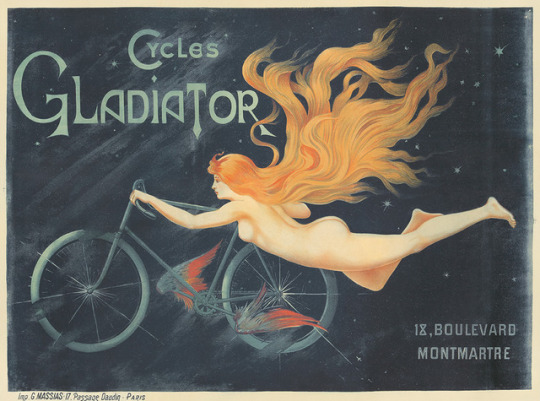
Cycles Gladiator. ca. 1895. Anonymous.
51 7/8 x 38 1/8 in./131.7 x 96.8 cm
A lithographic masterpiece. Acclaimed as one of the world's greatest posters, this image of a flame-tressed sylph, propelled among the stars by the Gladiator and its winged pedals, has been appropriated throughout culture ever since its debut in 1895. Shockingly, it remains anonymous, despite the presence of faint initials L.W. in the lower right corner.
Available at auction June 26. Learn More>>
#cycles gladiator#1890s#belle epoque#fin de siecle#art nouveau#masterpiece#ginger#redhead#nude#bicycles#bike#vintage bikes#vintage posters#posters#lithography#lithograph#litho#art on paper#paper#graphic design#typography#montmarte#stars#red hair#beautiful hair#vintage illustration#illustration#winged bike#sylph#winged pedals
144 notes
·
View notes
Photo

Dirnentragodie ("Tragedy of the Street"). 1927. Josef Fenneker.
36 1/2 x 72 1/8 in./92.7 x 183.2 cm
You can already see, in this riveting two-sheet poster, why the Danish actress Asta Nielsen was the first international star of silent film: the large dark eyes, a haunted face, her boyish figure. She often portrayed headstrong, passionate women trapped by tragic circumstances: transforming this melodramatic trope with naturalism and overt eroticism – leading her films to be heavily censored in the U.S. "Dirnentragodie," or 'Tragedy of the Street,' was Nielsen's final silent role. The film epitomizes the Weimar movement called The New Objectivity, which tried to create a middle ground between Brechtian alienation and Expressionist emotionalism by forcing middle-class characters into the oppressive social circumstances of the street. "Dirnentragodie" features Nielsen as an aging prostitute who takes in a young man running away from his middle-class family. She fantasizes about a different future; the man returns to his family; she's accused of murdering her pimp. This 1927 Fenneker design was used for the release of the film in Vienna.
#dirnentragodie#tragedy of the street#tragedy#ihatemondays#asta nielsen#silent film#big eyes#silent fim star#movie star#erotic#weimar#new objectivity#espressionist#brecht#prostitute#middle-class#pimp#german#Deutsch#vienna#1920s#weimar republic#deutsche plakate#deutsche plakat#plakat#vintage posters#affiche#graphic design#vintage illustration#jazz age
175 notes
·
View notes